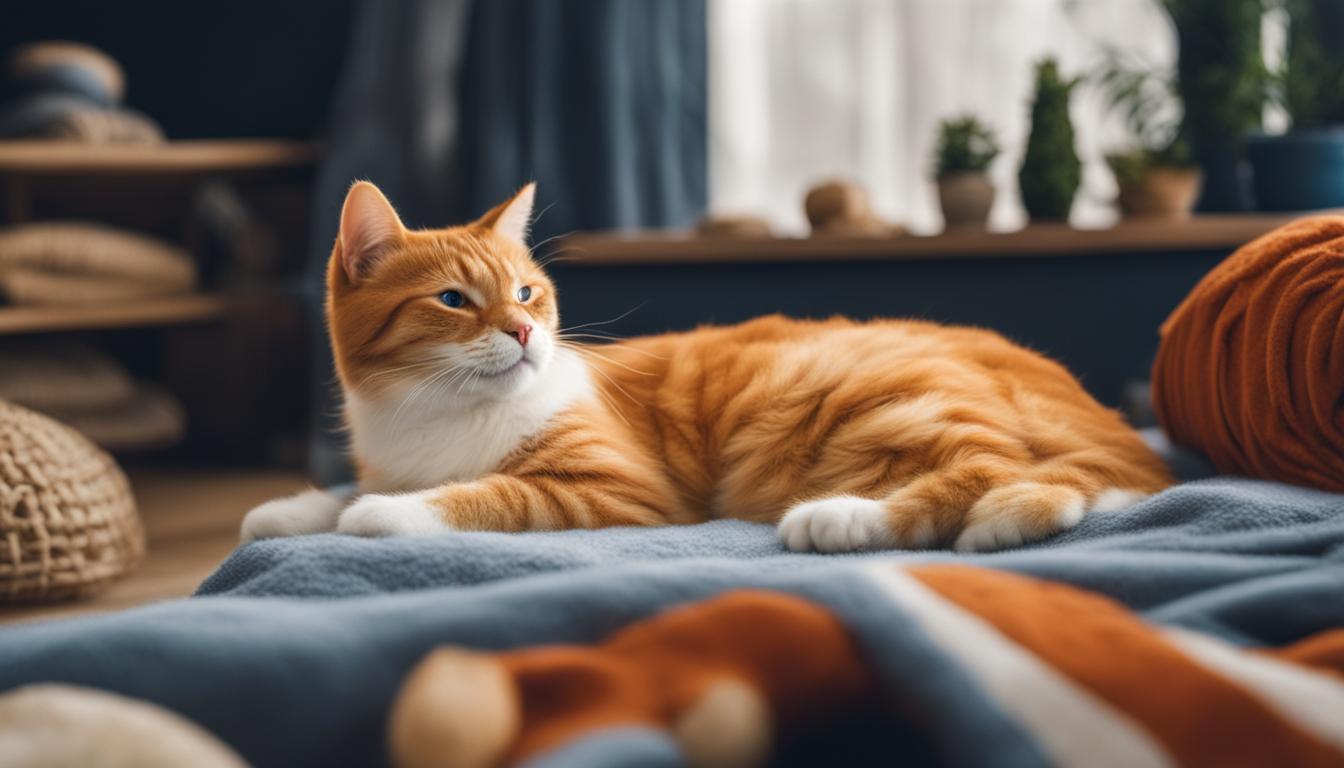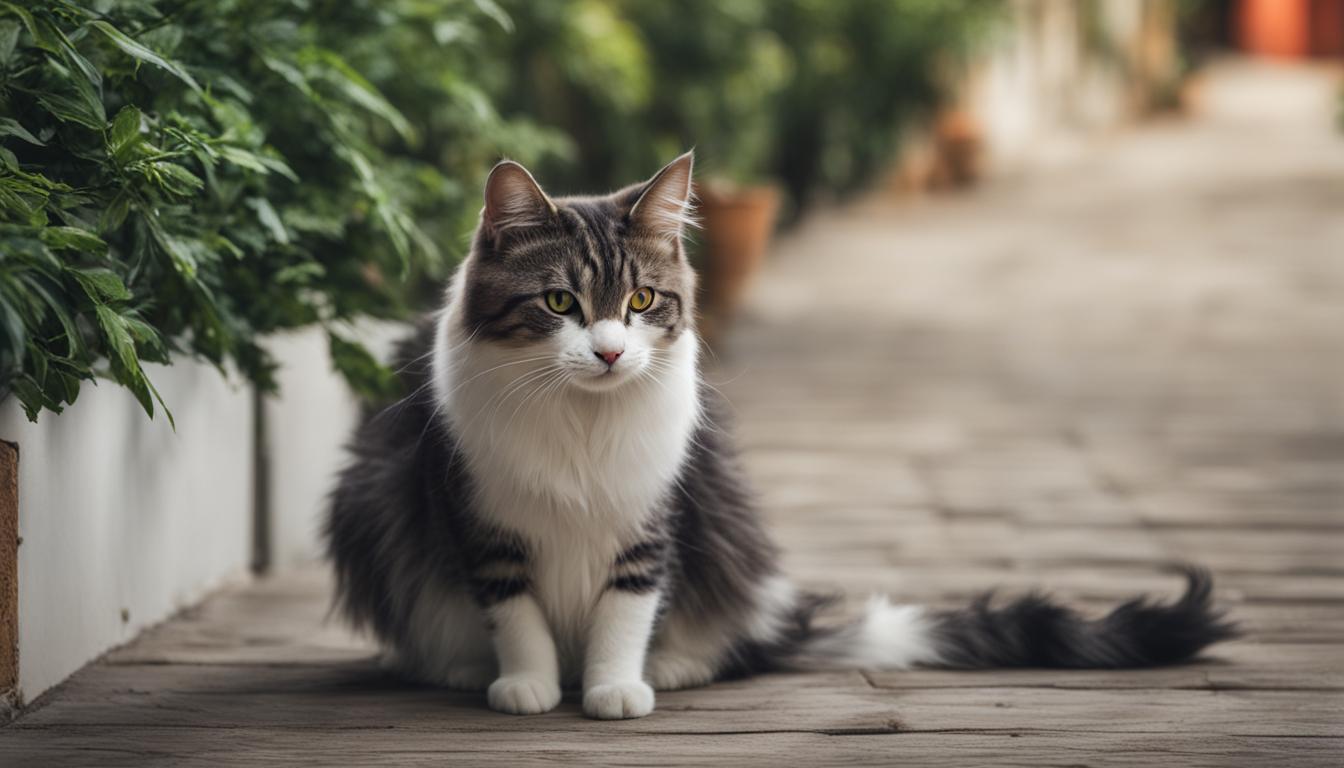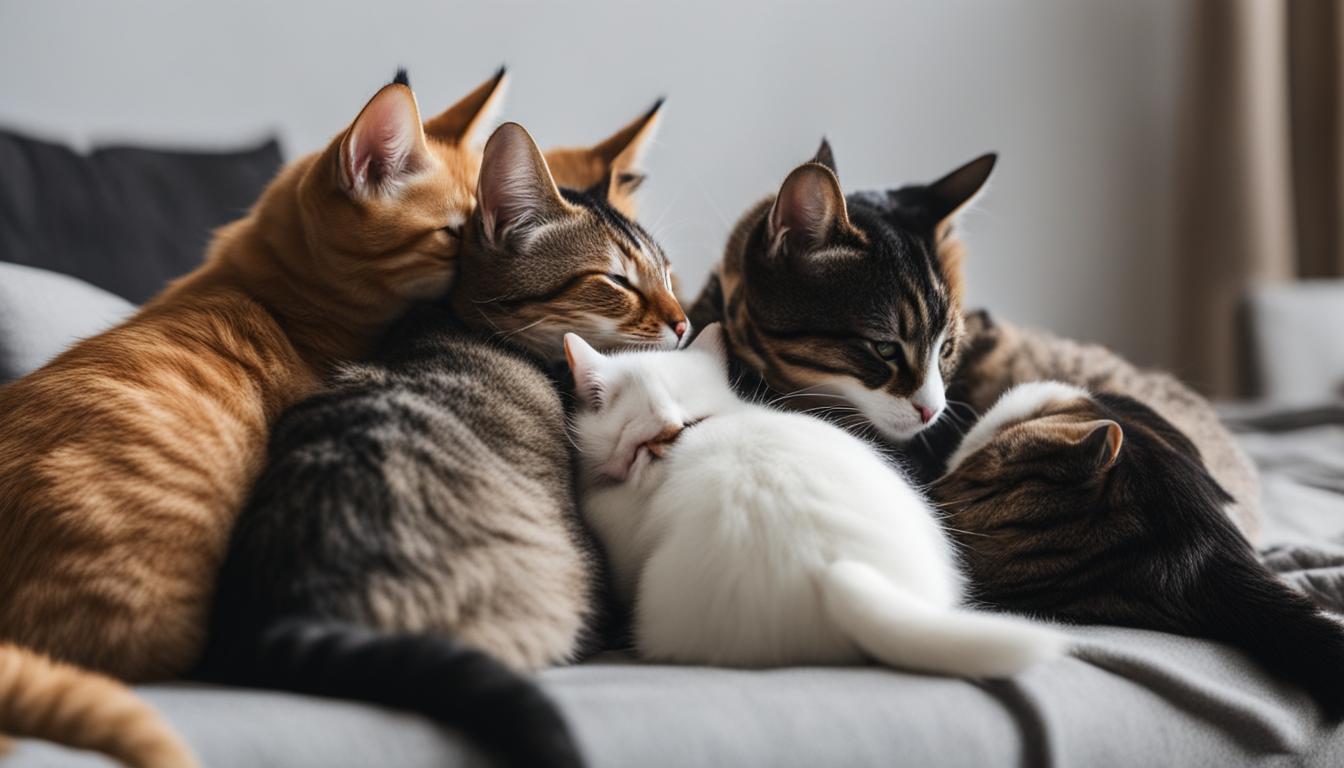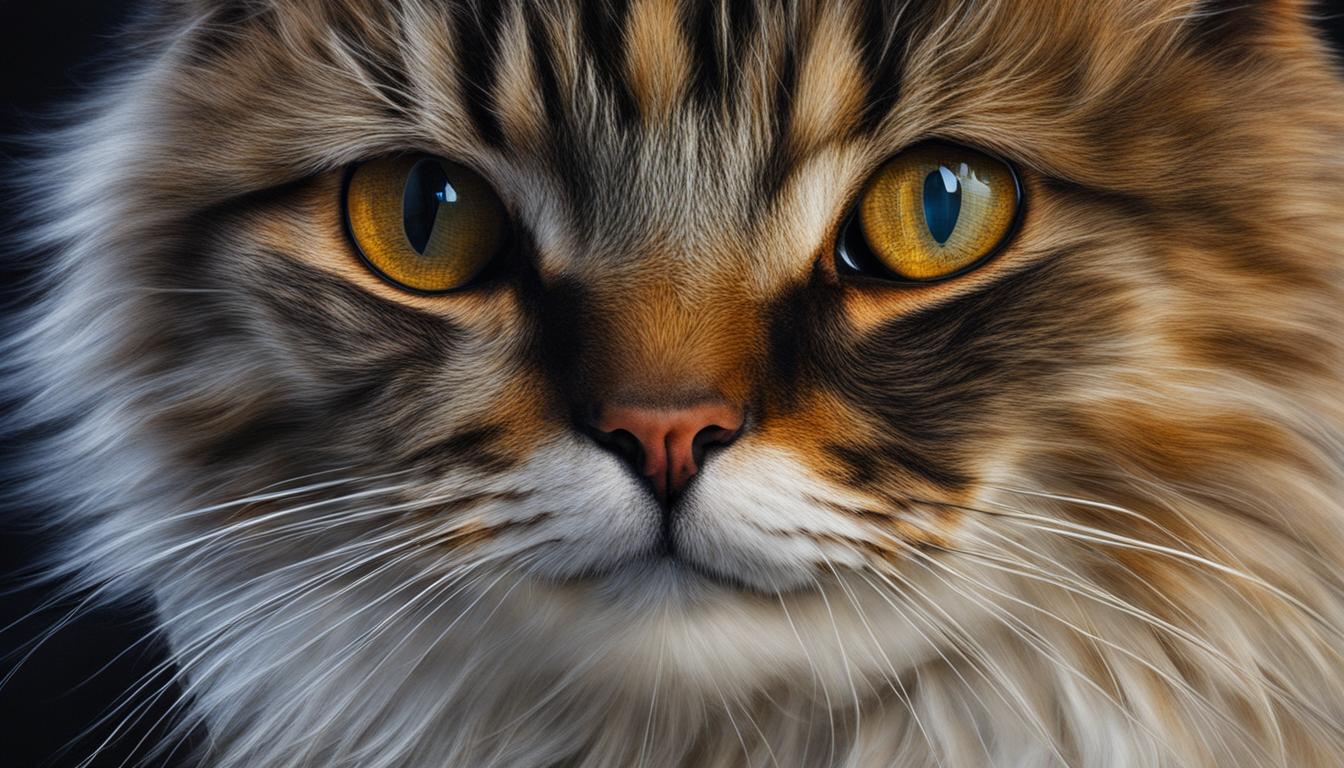Greetings, fellow feline enthusiasts! Today, I invite you on a journey to unravel the enigmatic behavior of cat kneading. Have you ever wondered why your furry friend engages in this peculiar action? Well, you’re in for a treat as we delve into the captivating world of cat kneading behaviors and the reasons behind them.
When it comes to cat kneading, there’s more than meets the eye. This rhythmic paw movement, reminiscent of making bread, holds fascinating insights into their instincts and early development. From stimulating milk flow during nursing to marking their territory and seeking comfort, cats’ kneading habits are as diverse as they are intriguing.
Key Takeaways:
- Understanding cat kneading habits can help strengthen your bond with your feline companion.
- Cat kneading behaviors are rooted in their early development, starting from when they stimulate milk flow during nursing.
- Kneading serves various purposes, including comfort, relaxation, territory marking, and exercise.
- Kittens instinctively use kneading to bond with their mother and seek nourishment.
- Kneading is a sign of contentment and happiness in cats.
The Instinctual Nature of Kneading
In the fascinating world of feline behavior, the act of kneading holds significant importance. This instinctual behavior can be traced back to a cat’s earliest days when they kneaded their mother’s teats to stimulate milk flow during nursing. This act of kneading, which involves rhythmic pushing and pulling motions of their front paws against a soft object, serves as a way for kittens to bond with their mother and ensure nourishment. As cats grow older, they continue to exhibit this behavior as a sign of contentment, happiness, and overall well-being.
Sign of Cat Happiness
Kneading is often accompanied by purring and drooling, indicating a state of intense pleasure for cats. It is a manifestation of their instinctual desire for comfort and security, reminiscent of the warmth and safety they experienced during their early days with their mother. The act of kneading serves as a positive indicator that cats are in a relaxed and content state, allowing them to release tension and find solace in their surroundings.
When observing your cat kneading, take a moment to appreciate the innate happiness and satisfaction they derive from this behavior. It is a testament to their overall well-being and the love they feel for their environment and those around them. As a dedicated cat owner, providing a comfortable and nurturing environment will only enhance your feline companion’s happiness and contentment.
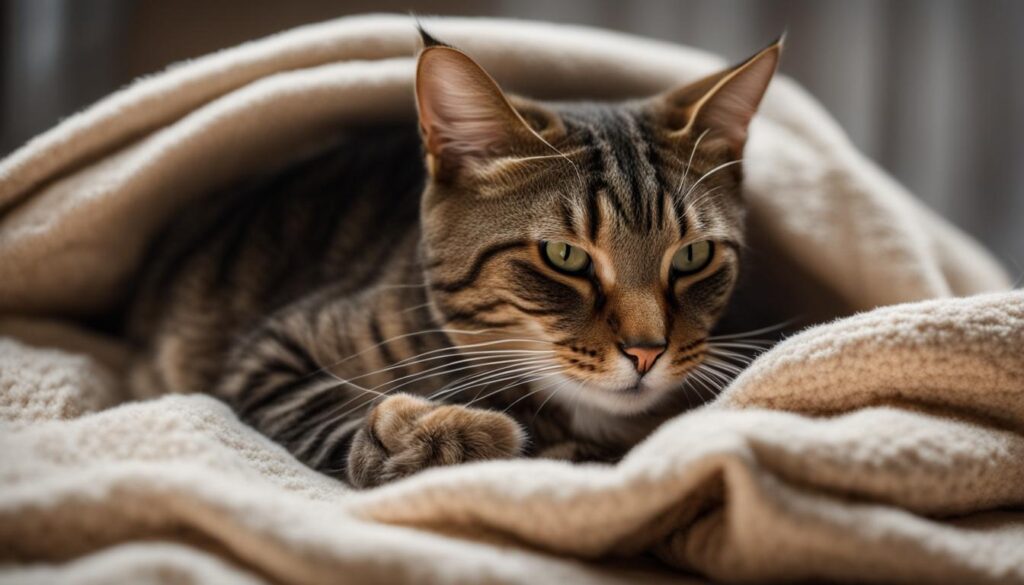
Table: Kneading as a Sign of Cat Happiness
| Behavior | Explanation |
|---|---|
| Purring | A sign of contentment and relaxation |
| Drooling | An expression of pleasure and intense satisfaction |
| Rhythmic motion | Reflects a sense of comfort and security |
| Bonding behavior | Reminiscent of their early days with their mother |
As you can see from the table, the combination of purring, drooling, rhythmic motion, and bonding behavior all contribute to the overall happiness that cats experience while kneading. It is a natural and instinctual expression of their well-being, and providing a safe and loving environment for your feline friend will only encourage this joyful behavior.
Territorial Marking through Kneading
When your cat kneads on blankets or other surfaces, it may seem like a cute and innocent behavior. However, there’s more to it than meets the eye. Kneading is actually a way for cats to mark their territory. How does this work? Well, cats have scent glands in their paws that release pheromones when they knead. These pheromones serve as a message to other cats, telling them that the area is already claimed.
Think of it as a cat’s way of saying, “This spot is mine!” By kneading on blankets or other objects, your cat is leaving their scent behind and establishing their ownership over that particular space. It’s like putting up a sign that says, “Keep out!” to other feline visitors.
So, the next time you catch your cat kneading on your favorite blanket, remember that they’re not just seeking comfort or practicing their milk-stimulating instincts. They’re also leaving their mark and letting the world know that this spot belongs to them.
| Benefits of Kneading | Why Cats Knead on Blankets |
|---|---|
| 1. Territory marking | 1. Leaving their scent behind |
| 2. Comfort and relaxation | 2. Mimicking the actions from nursing |
| 3. Exercise and flexibility | 3. Establishing ownership over a space |
“Kneading is like a cat’s way of putting up a sign that says, ‘Keep out!’ to other feline visitors.”
Understanding the territorial aspect of kneading can help you better comprehend your cat’s behavior. It’s just one of the many fascinating insights into the mysterious world of feline communication.
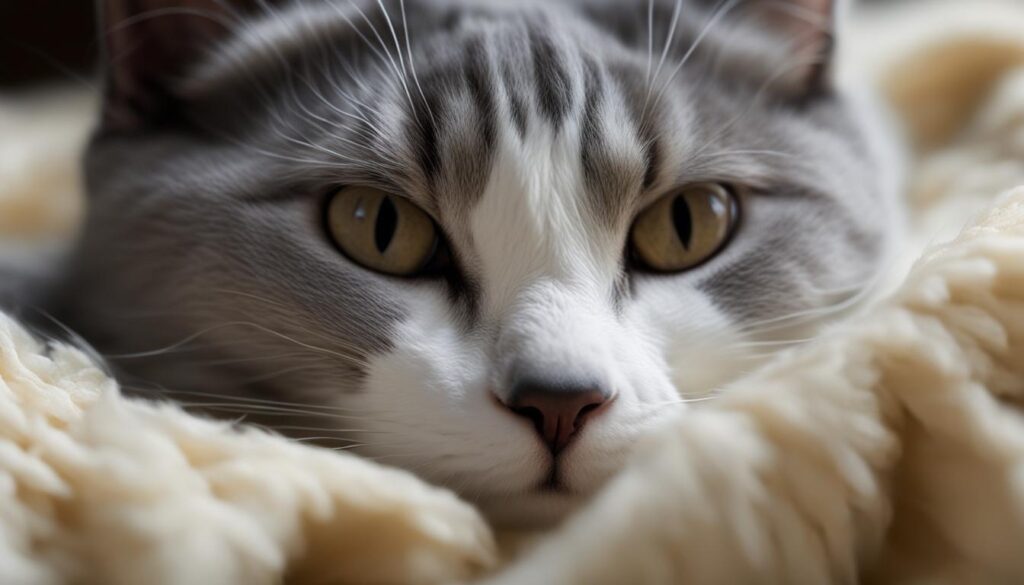
The Science Behind Territorial Marking
Research suggests that the scent released during kneading is a combination of pheromones and sweat glands. These scents are unique to each cat and can convey information about their age, sex, and even mood. While the main purpose of territorial marking through kneading is to establish boundaries, it can also serve as a form of communication between cats.
So, the next time you see your cat kneading on your favorite blanket, remember that they’re not just claiming their territory. They’re also engaging in a complex and sophisticated form of communication that is exclusive to the feline world.
Kneading for Comfort and Relaxation
When it comes to cats, kneading is not just a behavior associated with nursing or territory marking. It also serves a significant purpose in providing comfort and relaxation. The rhythmic motion and pressure against a soft surface have a calming effect on cats, making kneading a favorite activity before sleeping or during moments of contentment.
During kneading, cats often enter a state of pure bliss. As their paws push against a plush blanket or cushion, they are transported back to the soothing sensations they experienced while nursing. The act of kneading triggers a sense of security and comfort, allowing cats to unwind and de-stress.
Observing a cat knead can be a delightful experience. Their eyes may soften, their bodies relax, and they may even begin to purr. It’s as if they’ve found their own little oasis of tranquility in the midst of their everyday lives. So, the next time you see your furry friend kneading away, remember that it’s their way of finding serenity in the world.
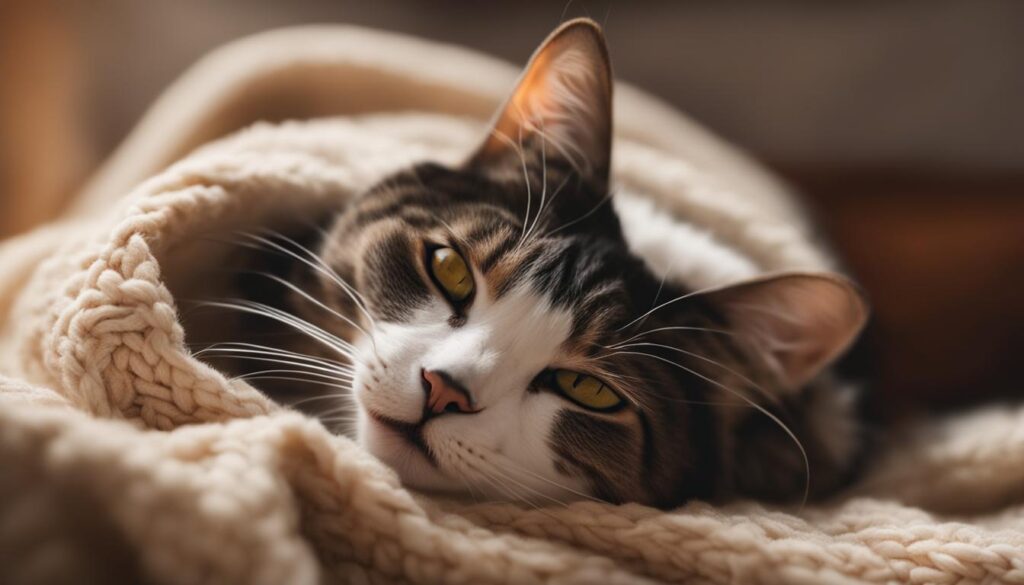
The Joy of Kneading
Cat kneading is a beautiful expression of feline happiness and well-being. It’s a reminder that even the simplest actions can bring immense joy to our feline companions.
Kneading is not only pleasurable for cats, but it also has physical benefits. The motion engages the muscles in their paws, legs, and shoulders, promoting healthy circulation and flexibility. For indoor cats who may have limited opportunities for exercise, regular kneading can be an essential part of maintaining their physical well-being.
Kneading for Exercise and Flexibility
When it comes to cat kneading, it’s not just about affection and comfort. This behavior also serves as a form of exercise and promotes flexibility in cats. The repetitive pushing and pulling motions of their paws engage the muscles in their legs, shoulders, and paws, providing a workout for their entire body.
Just like humans stretch and exercise to keep their muscles limber, cats use kneading as a way to maintain their physical well-being. This is especially important for indoor cats who may have limited opportunities for natural physical activity like hunting or climbing trees. Kneading helps them maintain healthy circulation and flexibility, preventing muscle stiffness and promoting overall fitness.
Additionally, kneading provides mental stimulation for cats, as it allows them to engage their instinctive behaviors in a controlled and safe environment. By engaging in this rhythmic motion, cats release pent-up energy and experience a sense of accomplishment.
The Benefits of Kneading for Cats:
- Promotes healthy circulation and flexibility
- Provides mental stimulation
- Helps release pent-up energy
- Engages instinctive behaviors in a controlled environment
So next time you see your furry friend kneading, remember that it’s not just a sign of affection, but also an important exercise routine for them. Providing them with appropriate surfaces for kneading, such as scratching posts or soft blankets, can help satisfy their kneading needs and keep them happy and healthy.
Table: Comparing Kneading Behaviors
| Behavior | Instinctual Nature | Comfort and Relaxation | Territorial Marking | Exercise and Flexibility |
|---|---|---|---|---|
| Primary Purpose | Stimulating milk flow during nursing | Seeking comfort and security | Marking territory | Promoting circulation and flexibility |
| Associated Signs | Purring, drooling | Calming, relaxed state | Releasing pheromones | Energetic, focused motion |
| Beneficial Effects | Bonding, nourishment | Stress relief, sleep preparation | Establishing ownership | Physical exercise, mental stimulation |
It’s fascinating to see how cats’ instinctual behaviors have evolved to serve multiple purposes. Whether they are kneading for comfort, marking their territory, or exercising their muscles, this behavior is a key part of their unique personalities and needs.
Adult Cats and Kneading Behavior
Understanding why adult cats engage in kneading behavior can help cat owners better interpret their feline friends’ actions. While kneading is commonly associated with kittens, adult cats may continue this behavior throughout their lives. The reasons behind their kneading habits remain similar to those of kittens, including comfort, relaxation, and territorial marking. However, there are additional factors that may influence an adult cat’s kneading behavior.
Social Rank and Self-Soothing
Adult cats may knead as a means of establishing their social rank within a household. Kittens often knead their mother’s belly to stimulate milk flow, and in adulthood, this behavior can be a way for cats to assert dominance or communicate their status to other cats in the household. Kneading can also serve as a form of self-soothing for cats, helping them cope with stress, anxiety, or even boredom. If a cat engages in excessive kneading or appears to be using it as a coping mechanism, providing alternative outlets for stress relief, such as interactive toys or scratching posts, can be beneficial.
Variations in Kneading Habits
Each cat has its own unique kneading style and preferences influenced by their individual personality and experiences. Some cats may knead vigorously, while others may exhibit a gentler and more delicate kneading motion. The choice of kneading surface can also vary among cats, from blankets and pillows to clothing or even their owner’s lap. Understanding and respecting these individual variations can strengthen the bond between a cat and its owner, as it allows for a better understanding of the cat’s needs and preferences.
| Reasons for Kneading | Examples |
|---|---|
| Comfort and Relaxation | Kneading before sleeping or when feeling content |
| Territorial Marking | Kneading on blankets or specific areas to claim ownership |
| Social Rank and Dominance | Kneading to establish dominance within a household |
| Self-Soothing | Kneading as a coping mechanism for stress or anxiety |
Overall, understanding the reasons behind an adult cat’s kneading behavior can provide valuable insight into their emotional state, needs, and preferences. It is important for cat owners to create a safe and comfortable environment that supports their cats’ natural behaviors, including providing appropriate surfaces for kneading and outlets for stress relief. By nurturing a cat’s instinctual behaviors, owners can strengthen their bond and promote overall well-being.
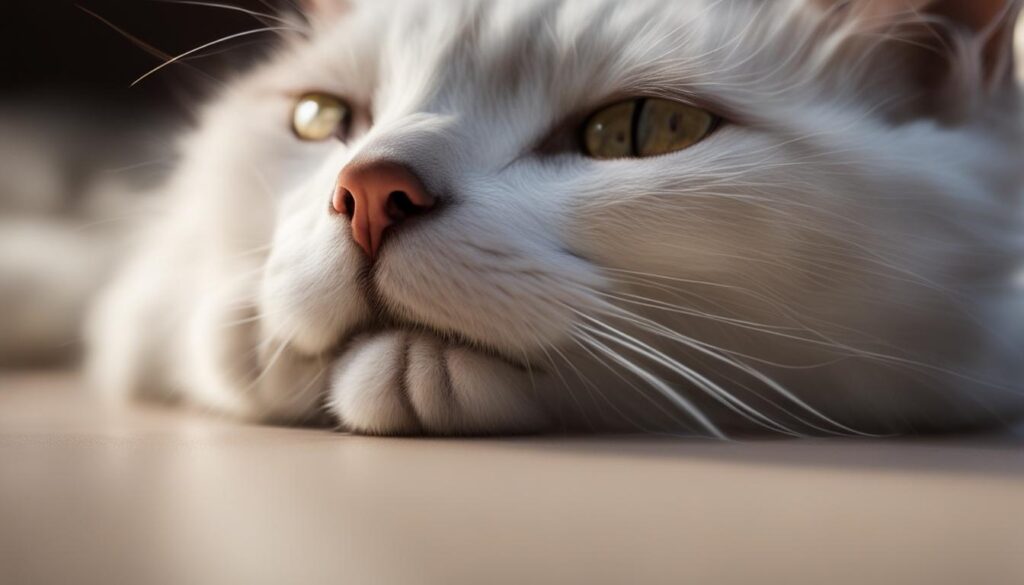
The Pleasure and Perils of Cat Kneading
As much as we adore our feline friends, their kneading behavior can sometimes lead to unexpected discomfort or even minor injuries. Understanding the reasons behind cat kneading and implementing effective strategies to manage this behavior is essential for both our cats’ well-being and our own. In this section, I will discuss the reasons behind cat kneading and provide practical tips for dealing with any uncomfortable or excessive kneading behavior.
The Affectionate Side of Cat Kneading
Cat kneading is often a display of affection and contentment. When your cat curls up on your lap, purring and rhythmically pushing their paws against your legs or abdomen, it’s a sign that they feel safe and loved. Kneading is an instinctual behavior that cats carry over from their early days of nursing, and it helps them create a cozy and secure environment. However, their claws can sometimes cause unintentional scratches, especially if they become overly enthusiastic. To prevent any mishaps, it’s important to trim your cat’s claws regularly and provide a suitable alternative for them to knead, such as a soft blanket or a designated kneading pad. This way, you can enjoy the affection without the scratches.
Reasons Behind Cat Kneading
Cat kneading serves various purposes, and understanding the underlying reasons can help us manage and redirect this behavior effectively. In addition to expressing affection, cats knead to mark their territory, stretch their muscles, and release pent-up energy. If you notice your cat kneading excessively or inappropriately, it may be a sign that they are seeking attention or are anxious. Providing plenty of interactive playtime and environmental enrichment can help alleviate these tendencies. Additionally, reinforcing positive behaviors and gently redirecting your cat’s attention to appropriate surfaces can help minimize any discomfort or damage caused by kneading.
Seeking Professional Help
If your cat’s kneading behavior becomes excessively aggressive or cannot be managed through simple interventions, it may be beneficial to seek guidance from a veterinarian or an animal behaviorist. They can provide personalized strategies and address any underlying issues that may be contributing to the behavior. Remember, each cat is unique, and what works for one may not work for another. By observing your cat’s body language and responding to their needs, you can create a harmonious environment that allows for both their natural behaviors and your own comfort.
| Potential Reasons for Cat Kneading | |
|---|---|
| 1. | Instinctual behavior carried over from kittenhood |
| 2. | Expression of affection and contentment |
| 3. | Territorial marking and claiming ownership |
| 4. | Stretching muscles and releasing energy |
| 5. | Seeking attention or alleviating anxiety |
Conclusion
After delving into the intriguing world of cat kneading behaviors, it’s clear that this unique behavior is a fascinating blend of instinct and personal comfort. Understanding the various reasons behind cat kneading habits allows us to better appreciate and nurture our feline companions.
From their earliest days as nursing kittens, cats instinctively knead to stimulate milk flow and create a bond with their mother. As they grow older, this behavior evolves into a means of seeking comfort and relaxation. The rhythmic motion and gentle pressure against a soft surface provide a sense of security and contentment.
It’s important to recognize that kneading also serves as a form of territorial marking for cats. By releasing pheromones from their paw glands during the kneading process, they communicate ownership over a particular spot. This behavior is their way of asserting their presence and establishing their territory.
To ensure the well-being of both cats and their human companions, it’s crucial to redirect the kneading behavior to appropriate surfaces. Providing scratching posts or designated blankets can help satisfy their need to knead without causing unintended scratches or injuries. If the behavior becomes excessive or unmanageable, seeking guidance from a veterinarian or animal behaviorist is recommended.
In conclusion, cat kneading behaviors are a complex amalgamation of instinct, comfort-seeking, and territorial-marking behaviors. By understanding the reasons behind their kneading habits, we can deepen our bond with our furry friends and create an environment that nurtures their natural inclinations. So the next time your cat starts kneading, embrace this curious behavior and enjoy the unique connection it brings.
FAQ
Why do cats knead?
Cats knead for various reasons, including comfort, relaxation, territory marking, and exercise.
Why do kittens knead?
Kittens instinctively knead to stimulate milk flow from their mother’s teats during nursing. It helps them bond with their mother and provides nourishment.
What does kneading indicate in cats?
Kneading is a sign of contentment and happiness in cats. It is often accompanied by purring and drooling.
Why do cats knead on blankets or other surfaces?
Cats have scent glands in their paws that release pheromones when they knead, marking their territory. Kneading on blankets or other surfaces is a way for cats to claim ownership over that particular spot.
Is kneading a form of relaxation for cats?
Yes, kneading mimics the actions cats performed while nursing, which they found soothing and secure. Many cats knead before sleeping or when they are in a relaxed and content state.
Does kneading serve any physical purpose for cats?
Yes, kneading serves as a form of exercise for cats. The repetitive motion engages the muscles in their paws, legs, and shoulders, promoting healthy circulation and flexibility.
Do adult cats knead as well?
Yes, adult cats may continue to knead throughout their lives. The primary reasons remain the same, including comfort, relaxation, and territorial marking.
What should I do if my cat’s kneading behavior becomes aggressive?
If your cat’s kneading behavior becomes excessively aggressive or cannot be managed, consulting with a veterinarian or animal behaviorist for guidance and support is recommended.

